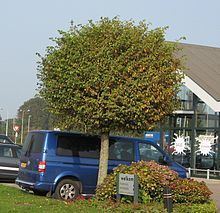Cultivar 'Umbraculifera' | Origin Iran | |
 | ||
Similar Ulmus 'Purpurea', Ulmus minor 'Argenteo‑Variegata', Ulmus 'Nanguen' = Lutece, Ulmus 'Wanoux' = Vada, Ulmus 'Camperdownii' | ||
The Field Elm cultivar Ulmus minor 'Umbraculifera' [:shade-giving] was originally cultivated in Iran, where it was widely planted as an ornamental and occasionally grew to a great size, being known there as 'Nalband' Persian: نعلبند [:the tree of the farriers]. Litvinov considered it a cultivar of a wild elm with a dense crown that he called U. densa, from the mountains of Turkestan, Ferghana, and Aksu. Non-rounded forms of 'Umbraculifera' are also found in Isfahan Province, Iran. Zielińksi in Flora Iranica considered it an U. minor cultivar.
Contents
'Umbraculifera' was introduced to Europe in 1878 by the Späth nursery of Berlin, by one account from a German gardener in the employ of the Shah of Persia, by another from M. Scharrer, inspector of Tiflis Imperial Gardens, Georgia. It was subsequently planted along streets in Berlin.
'Umbraculifera' was introduced to the USA in 1912 as "Karagatch" (Ulmus densa syn. U. campestris [:U. minor] 'Umbraculifera') at the USDA's Chico Plant Introduction Station in California by Frank Meyer, who collected it from the Russian imperial estate at Murgrab, Turkestan (see photo taken by Meyer in Notable trees below).
Green mistook Späth's U. turkestanica Regel (the U. 'Turkestanica' of his Register of Cultivars) for a synonym of 'Umbraculifera'. U. turkestanica Regel was first mentioned in Dieck in 1885, Regel himself later stressing that "U. turkestanica (p. 36) was only a preliminary name given by me; I regard this as a form of U. suberosa [:U. minor]". Späth listed U. turkestanica Regel and U. campestris umbraculifera separately in his catalogue of 1903, U. turkestanica being described as "a densely growing, small-leaved tree of upright growth, close to U. pumila", while 'Umbraculifera' appears as: "Ball elm. Transcaucasia, Persia. Needs no pruning. Valuable as a single tree, free-standing in park or street". Three U. turkestanica Regel were supplied in 1902 by Späth to the Royal Botanic Garden Edinburgh. A tree accessioned by that name at the RBGE's Benmore garden in Argyll in 1902, and surviving (2016) almost certainly as a sucker or cutting of one of the three originals, was, following Green's confusion of 'Turkestanica' and 'Umbraculifera', long believed to be 'Umbraculifera'. 'Umbraculifera', however, though present in Späth's 1903 catalogue, does not appear in the RBGE 1902 accessions list from Späth. Being grafted, it does not sucker. (Later still the tree was misidentified by the Garden as U. pumila L. var. arborea Litv., though the leaves do not match those of the latter cultivar.) U. turkestanica Regel was also confused by some authorities, notably Elwes and Henry in their Synonymy list, with the Siberian Elm cultivar originally called U. pinnato-ramosa'.
Description
The tree is distinguished by its dense, rounded, sometimes flat-topped habit. Henry's statement (1913) that "it differs from ordinary U. nitens [: U. minor] only in its peculiar habit" suggests that, in one form of the tree at least, the leaf is not distinctive. A leaf-specimen labelled U. umbraculifera held in the herbarium of the Muséum National d'Histoire Naturelle appears to confirm this suggestion. However, a leaf-specimen labelled U. umbraculifera Späth held in the herbarium of the Naturalis Biodiversity Center in Leiden shows that the clone marketed by the Späth nursery had a distinctive, almost rhomboidal leaf. It is said that the tree is always grafted on to U. minor standards.
Pests and diseases
The tree is as vulnerable to Dutch elm disease as the species; a specimen at the Ryston Hall [2], Norfolk, arboretum, obtained from the Späth nursery before 1914, was killed by the earlier strain of the disease in the 1930s.
Cultivation
The tree was introduced to the Caucasus, Armenia and Turkestan, and it remains in cultivation in central and south-west Asia. Bean remarked that the tree succeeded well on the continent (Europe) and in eastern North America, but was rarely planted in the UK. Introduced to Australia, the tree was marketed in the early 20th century by the Gembrook Nursery near Melbourne and by Searl's Garden Emporium, Sydney, but it is not known whether the tree survives in that country. Despite its susceptibility to Dutch elm disease, it remains in commercial cultivation in Belgium and the Netherlands.
The Field Elm cultivar Ulmus minor 'Umbraculifera Gracilis' was obtained as a sport of 'Umbraculifera' by Späth c.1897-8.
Notable trees
Regel's Gartenflora (1881) contains an illustration, mentioned by Elwes and Henry in their account of 'Umbraculifera', of a great old tree near Eriwan. An avenue of the trees once grew at the Russian imperial estate of Murgrab at Bairam-ali near Merv, formerly Russian Turkestan.
